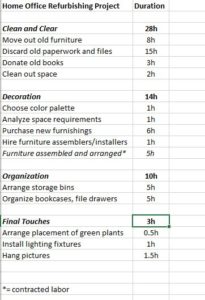Managing a Project with a Volunteer Team
You’re a project manager, right? So, when you’re at home, you take the project management hat off, right? Wrong! You apply similar principles that you use in your organization to getting projects done at home. Case in point: I recently reorganized/refurbished my home office. I had a small idea of what this project would entail, but, as with any project, there were uncertainties and risks. One of the uncertainties was dealing with a volunteer team that helped to clear out the old furnishings and streamline what was kept as well as a volunteer decor team. No, it’s not as complex as some of the projects that we manage in IT, but it was still important to apply some of the key tools and techniques of project management to this home project.
Stakeholders: The primary stakeholder of this project was me, the homeowner. My main concern for the project was that the available resources were utilized efficiently and that the final product would provide maximum utilitarian use. The ancillary stakeholders would be those who participated in the project, where their reputations became the currency.
Communication: The exchange of information that primarily occurred on this project was internal communication — that is between me, as the project manager, and the volunteer team members who were part of the project. The method of communication occurred mostly via text messages and phone calls. Those messages were conveyed on a semiweekly basis with the participants that were necessary for the next particular phase of the project.
Schedule, Cost, Quality: This was a 4-month project utilizing the following duration timeline:

The cost (budget) for the project was $2000, which mainly included purchasing the furnishings, paintings, and lighting. A small percentage of the budget was allocated for appreciation gifts, beverages and refreshments.
Advertisement
[widget id=”custom_html-68″]
Quality for the project meant understanding how the project would meet the needs for which it was created. The project was created to refurbish and revitalize my home office so that it was a calm and effective workspace. This was accomplished by determining my requirements for the end product and acquiring the best services and products at a reasonable cost that met my standards. Items purchased should be durable and match the new color scheme for the office. Quality also entails trusting that everyone on the project team understands what is expected of him or her as well as their willingness to meet those expectations. This aspect of quality was communicated to each project participant prior to their commitment to work on the project. I served as the final authority to make the necessary decisions when corrective actions were warranted.
Scope: The scope of the project included removing 90% of the old decor in the office, removing clutter and unused items such as old paperwork, files, books, etc., items that no longer brought me joy, organizing and storing the remaining books, purchasing new furnishings, and creating an open floor plan. The scope did not include removing any walls or doors, painting the walls or replacing the flooring.
Multi-generational Team Management and Coordination: The project team was strictly voluntary team consisting of the decoration lead, clearing lead, cleanup crew (3), organizing/decor team (3). The team members had varying levels of experience; this helped in many ways to streamline the process and also, for those team members with minimal experience, to slow down the process as well. The availability of this volunteer team was an issue since several had other projects going on and were unavailable during parts of the project. The team members were present and working for a minimum of 6 hours on the days they were scheduled; breaks and refreshments were served. Team members generally worked every other weekend with one team member on site either on a Saturday or a Sunday; during the clearing and cleaning phase, a couple of team members were present for one Saturday. Working with Gen Xers and Millennials was an interesting experience as far as the levels of commitment and the differences in communication styles. While most participants understood the vision that I had for the final product, Gen Xers stayed on task with getting the work done whereas Millennials tended to need more guidance on the task at hand in order to complete the work
Success/Customer Satisfaction: Overall, the project was a success. The main criteria that were used to determine whether the project was a success or not comprised: (1) staying on budget; (2) the overall aesthetics and energy of the office; (3) ease of use for accessing various items in the office; (4) furnishings that conveyed calm/openness and provided ample storage; (5) sufficient natural light; and (6) the incorporation of greenery. Using various light sources including the natural light that streams through the patio window as well as multiple artificial light sources was an important element as for as creating a diverse ambience for completing various tasks/work. Everyone was thanked for their work and participation on the project; the team leads were provided with appreciation gifts.
Lessons Learned: The lessons learned on this project are things to keep in mind for any future home projects. These particular lessons were:
- Ensure the availability of resources that are scheduled to complete tasks by certain days (and making sure that all affected parties are aware of that availability).
- Have more oversight over the demolition crew (who ended up throwing away a couple of binders that were important).
- Make sure that the communication channels are clear and that updates are provided in a timely manner to all concerned (there were a couple of times when I expected the team member to be present and their absence was communicated to someone else on the team but not to me).
